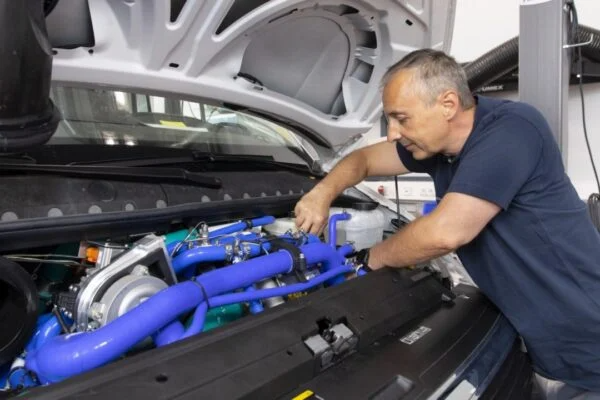Battery drives for vehicles are in vogue, but they reach their limits when it comes to long distances and heavy vehicles. Under such operating conditions, the fuel cell can show off its strengths. Bosch, which has long been a committed developer of fuel cell drives, has now equipped two vans with them and started test operations on the road.
The results confirm the advantages of this technology. “The fuel cell enables long ranges and short refueling times, which makes long journeys more economical,” says Markus Heyn, Bosch board of management member and chairman of the Mobility Solutions division. “With our two fuel cell transporters, we are expanding our understanding of the system and showing that the fuel cell can also be a suitable drive solution for light commercial vehicles.” The partner in the project is Abt eLine GmbH, which designed and carried out the conversion of the vehicles together with Bosch Engineering.
For the fuel cell system, the developers were able to rely almost entirely on Bosch components. A fuel cell kit is used, which comprises the stack, the anode supply module including hydrogen metering valve and recirculation blower, the control unit, the electric air compressor and storage components, and even a large number of sensors. The technical basis of both vehicles is formed by purely electrically powered vans that are freely available on the market. For its tests, Bosch replaced the batteries, including peripherals, with the fuel cell, five storage tanks for a total of more than ten kilograms of hydrogen, and a smaller lithium-ion battery.
- Stellantis introduces fuel cell drive for light trucks
- Toyota sends fuel cell trucks into practical tests
- BMW launches production of fuel cell powertrains
“Accommodating the fuel cell components in the existing installation space was a major challenge,” says Uwe Gackstatter, chairman of the Bosch Powertrain Solutions division responsible for the project. Among other things, the partner ABT eLine adapted the cooling system, as well as the vehicle control system and the electrical wiring system. Bosch designed the fuel cell system, integrated it into the vehicle together with the hydrogen storage system, and developed the associated control system. Following the necessary technical tests, the vehicles have been granted road approval.
The project is delivering important findings: Even loaded, the vehicles can travel up to 540 kilometers, and after just six minutes they are fully refueled again. For fleet operators whose vans cover particularly long distances during the day and return to the depot in the evening, the fuel cell could therefore be a good complement to the battery-electric drive in the future, according to the Bosch experts.
The first Bosch components for fuel cells are already in series production. But the work is not done there. “For further development, we need as much data as possible from real driving operations,” explains Gackstatter. Thanks to cloud connectivity, the two test vehicles now deliver this data in real time to the developers’ computers, supplementing the measured values from the test rigs. With this knowledge, Bosch will be able to offer customers components that have been tested even earlier and comprehensive support in system design.
- Schaeffler, Symbio establish fuel cell JV
- Daimler Truck tests fuel cell truck with liquid hydrogen
- China fuel cell joint ventures for Bosch, Ceres
However, further steps are needed for the breakthrough of fuel technology. “Industry and politics must work together to remove obstacles to hydrogen technologies,” warns Gackstatter. Among other things, the development of a tank infrastructure and the production of green hydrogen in larger quantities remain tasks that can only be solved together.
At the IAA Transportation (September 20-25, Hanover, Germany), Bosch will offer interested visitors the opportunity to see the test vehicles and Bosch fuel cell technology in action.



Leave a comment